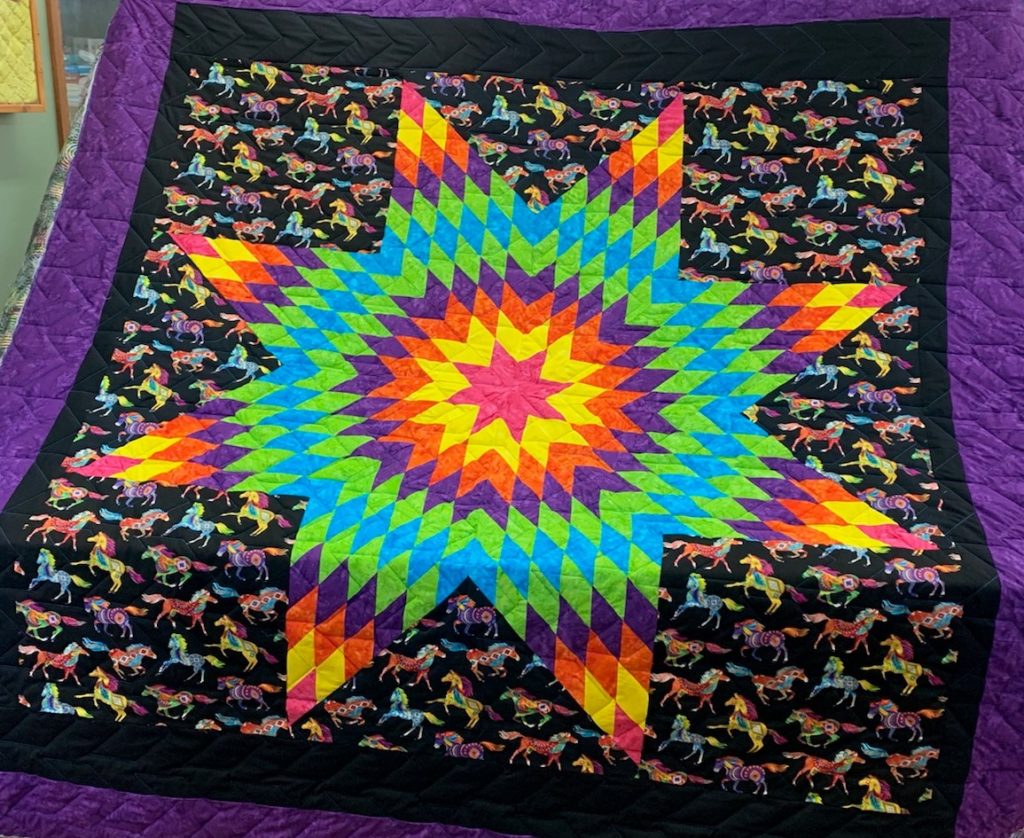They Represent Honor and Generosity
(Editor’s note: Having grown up on the Rosebud Reservation and in poverty, I often feel that my background has given me a unique perspective on many subjects. I’d like to share a story about star quilts and urge people to consider purchasing one as a gift or for a special ceremony. Email: bandlandsquilting@goldenwest.net or call (605)685-1209.)
On the Reservation, star quilts are given to mark important life events. For the Lakota and Oglala (Sioux) people, the star quilt — wičháȟpi owíŋža — represents honor and generosity.
Initially, buffalo hides were draped around the shoulders of Lakota warriors and hunters when they returned from battle, a successful hunt, or at the start of Haŋblečeya (vision quests). The hides were also presented at funerals to honor loved ones on their final journey.
With the government’s policy that allowed mass shooting of the bison (tatanka), which sent Native Americans to reservations and prompted the arrival of settlers and missionaries, textiles replaced the hides.
Star quilts are a living tradition: they are not just blankets or quilts. Every patch represents a person (although there is no name on it) and it means that you are surrounded by those who love you and support you – you are kept, protected and cared for.
The star quilt is made of small diamonds pieced together in eight sections, which are joined together to create an eight-point star. The star is inspired by the Morning Star, the last brightest star in the eastern horizon before dawn.
According to Lakota legend, the Morning Star represented the way the spirits came to earth and served as a link between the living and those who have passed.
Star quilts are one of the most valued gifts of the Lakota (Sioux) people and are used for banners in schools for graduations and other school functions and to mark life events such as a wedding or a child’s birth. The quilts are also given to special people at Giveaways.
Giveaways have always been part of Lakota society. At important events, the family gathers their belongings and sets them out for any person in the community to take. “What you give away, you keep; what you keep, you lose” is an old Lakota saying.
According to “The Changing Role of the Giveaway Ceremony in Contemporary Lakota Life,” an abstract by Elizabeth Grobsmith, “Gift-giving ceremony of the Lakota was indigenously both an economic institution in which goods were exchanged and with redistributed as well as religious and economic functions.”
Lydia Whirlwind Soldier writes in “Wancantognaka: The Continuing Lakota Tradition of Generosity” that “Giveaways are part of every ceremony–wopila (thanksgiving), wokiksuye (memorial), or yuonihan (honoring).
“These ceremonies reverberate the commitment of caring and the sharing ethic, the generosity of heart of our forefathers. Employed tribal people still share their advantages and benefits with their tiyospaye (extended families). Even the poorest of families save for a year to accumulate and make articles to give away in memory of their loved one.
“According to Lakota winter counts, the Spirit Keeping ceremony was brought to the Lakota by the White Buffalo Calf Woman about 3,000 years ago, and it survives today. The ceremony begins at the time a loved one passes into the spirit world.
“A designated family member takes a lock of hair and keeps it in a special place. The year of Spirit Keeping gives time to heal from losses, examine and learn from the lifestyle of the deceased, and develop habits to carry for a lifetime. The extended family heartens and comforts the grieving family members as they work together to prepare gifts. At the end of the year, they gather for the Soul Releasing Ceremony.”
Often, numerous significant people to the deceased receive a star quilt at a giveaway. Numerous other items are also given away.
Wacantognaka, the Lakota word for generosity, means to contribute to the well-being of one’s people and all life by sharing and giving freely. This sharing is not just of objects and possessions, but of emotions like sympathy, compassion and kindness. It also means to be generous with one’s personal time. The act of giving and not looking for anything in return can make you a better person–and happier.

Clerks in the quilting star assemble individual quilts as well as sell material to those who make the quilts.
(To learn more about star quilts, listen as my former eighth-grade PE teacher Vi Colombe explains the meaning. Visit: https://www.youtube.com/watch?v=KcTNT6CNddU&feature=youtu.be)




Such an inspiring story, Sue! Please consider giving a talk on this subject to our club. With deep gratitude, Kane
Thank you I look forward to receiving one soon .